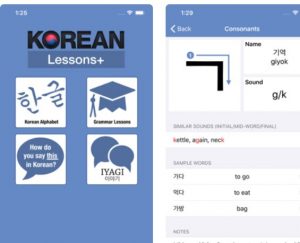
The Korean alphabet consists of vowels and consonants just like in English. There are in total 21 vowels 모음(10 basic vowels, 11 other vowels) and 19 consonants 자음 (14 single consonants, 5 double consonants).
The very first thing in learning the Korean language is to memorise how to write and pronounce the sound of all the vowels and consonants like how you memorise the alphabet if you want to learn English.
Below are some free resources on the Internet that allows you to do this:
There are abundant mobile apps and resources on the web / youtube. Because it is very straightforward so it wouldn’t make much difference which one you choose.
Some people say it is very difficult to remember all these alphabets. One good tip I find useful is to look at the name of the actor or singer you like best. For example I love watching Running Man and the members have name stickers stuck onto their backs. One member called Haha’s name in Korean is 하하. Only by remembering this, I will know ㅎ is pronounced as H and ㅏ is pronounced as Ah. Only by analysing the names of maybe two or three celebrities, you can probably cover a good variety of alphabets, and the rest will fall into place naturally. I have written a full post on how remember Korean letters easily.
Another tip is to read the letters out loud while writing out the letters. This not only gives you the opportunity to practice your Korean handwriting but also reinforces your memory of the pronunciation at the same time. I have made a printable PDF worksheet for Korean alphabet handwriting practice.
Difference between ㄱ, ㅋ, ㄲ
There are a lot of resources including YouTube videos teaching you the difference – this is a good one by TTMIK. Clearing the most effective way to train your ears to differentiate between these is to listen to how natives pronounce them a lot. However this is definitely not something you should bother yourself with as a beginner. Why? It is because Korean is not always spoken as they are spelt, i.e. there are certain sound change rules. This actually happens more often than not. For example when you think natives are saying 좋겠다, actually it is pronounced as 좋켔따. Of course you will not be able to tell the difference! You will just get more confused the more you listen! I would suggest to focus on this only after you learn the sound change rules in the intermediate level instead of overwhelming yourself at the moment.
At the end of the stage you should be able to:
- Write all of the Korean alphabets
- Pronounce the sound of all Korean alphabets
- Know how to assemble the alphabets to become Korean words 글자
- Pronounce Korean words
- Have a basic concept that there are sound changes when certain alphabets meet
It is not necessary at this point to:
- Distinguish between for example ㄱ, ㅋ, ㄲ with precision, though you should know the difference in principle
- Remember all of the sound change rules
- Know the name of the alphabet. For example in English the first alphabet (A), it’s name is Eei, while it pronounces as Ah. ㄱ is pronounced as k/g while its name is 기역
- Remember the sequence of the vowels and consonants



ok